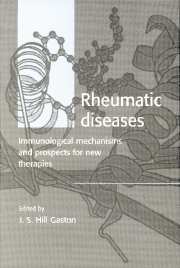Book contents
- Frontmatter
- Contents
- List of contributors
- 1 Implications of advances in immunology for understanding the pathogenesis and treatment of rheumatic disease
- 2 The role of T cells in autoimmune disease
- 3 The role of MHC antigens in autoimmunity
- 4 B cells: formation and structure of autoantibodies
- 5 The role of CD40 in immune responses
- 6 Manipulation of the T cell immune system via CD28 and CTLA-4
- 7 Lymphocyte antigen receptor signal transduction
- 8 The role of adhesion mechanisms in inflammation
- 9 The regulation of apoptosis in the rheumatic disorders
- 10 The role of monokines in arthritis
- 11 T lymphocyte subsets in relation to autoimmune disease
- 12 Complement receptors
- Index
11 - T lymphocyte subsets in relation to autoimmune disease
Published online by Cambridge University Press: 06 September 2009
- Frontmatter
- Contents
- List of contributors
- 1 Implications of advances in immunology for understanding the pathogenesis and treatment of rheumatic disease
- 2 The role of T cells in autoimmune disease
- 3 The role of MHC antigens in autoimmunity
- 4 B cells: formation and structure of autoantibodies
- 5 The role of CD40 in immune responses
- 6 Manipulation of the T cell immune system via CD28 and CTLA-4
- 7 Lymphocyte antigen receptor signal transduction
- 8 The role of adhesion mechanisms in inflammation
- 9 The regulation of apoptosis in the rheumatic disorders
- 10 The role of monokines in arthritis
- 11 T lymphocyte subsets in relation to autoimmune disease
- 12 Complement receptors
- Index
Summary
Introduction
The immune system has evolved a wide variety of potent mechanisms for the elimination of pathogens. As these mechanisms are potentially damaging to the host, an essential feature of the adaptive immune response is that it should be able to distinguish self from non-self and respond, when appropriate, only to the latter. The failure of the immune system to make this distinction can result in autoreactive cells mounting immune responses against self tissues, causing life-threatening pathology. There are now an increasing number of diseases in which an autoimmune process has been implicated in the pathogenesis, including RA, insulin-dependent diabetes mellitus (IDDM), multiple sclerosis, thyrotoxicosis, systemic lupus erythematosus (SLE), autoimmune haemolytic anaemia and myasthenia gravis to name a few. In order to avoid the damaging reactions that can cause this type of disease, the immune system has evolved a number of strategies for preventing autoreactive cells from making responses against host tissues, thus maintaining a state of self-tolerance.
In broad terms, mechanisms of self-tolerance can be categorized into two different classes. In the first, tolerance is maintained by both intra- and extrathymic mechanisms. Autoreactive T cells that encounter self-antigen within the thymus are clonally deleted (Kappler, Roehm & Marrack, 1987) while autoreactive cells that escape this process are either rendered anergic (Mueller, Jenkins & Schwartz, 1989), a state thought to result from the non-immunogenic presentation of self-antigens, or simply fail to respond to self-antigens, a state known as clonal indifference (Ohashi et al., 1991).
- Type
- Chapter
- Information
- Rheumatic DiseasesImmunological Mechanisms and Prospects for New Therapies, pp. 225 - 244Publisher: Cambridge University PressPrint publication year: 1999



